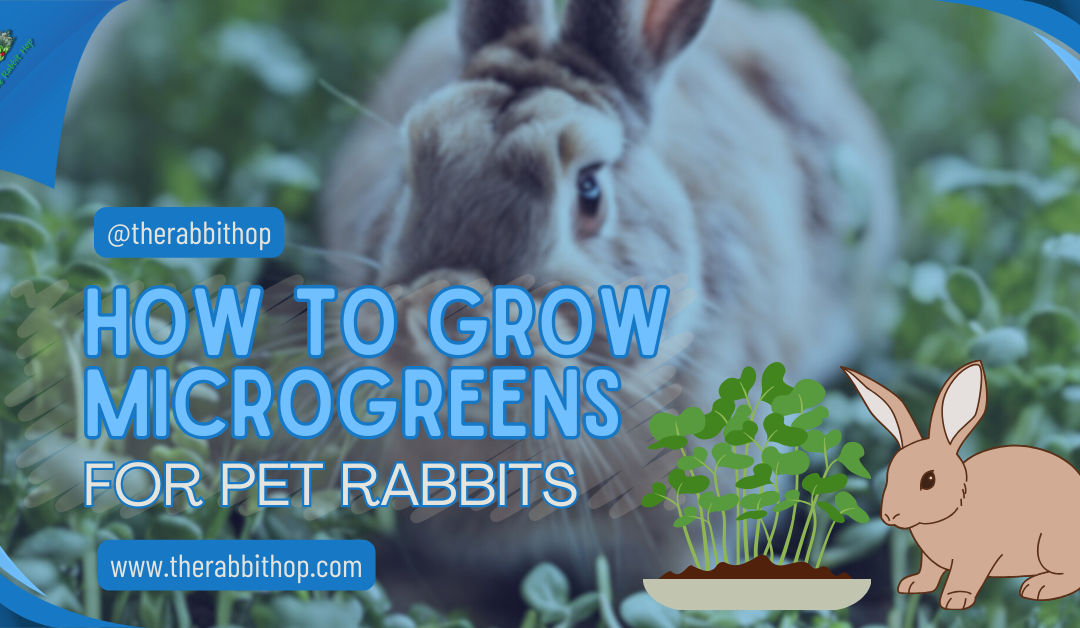Introduction to Microgreens: What Are They?
You’ve probably seen microgreens adorning your gourmet salad or used as a garnish at your favorite upscale restaurant. But do you know what they are? Microgreens are young, tender, edible seedlings of vegetables and herbs. Unlike sprouts, which are germinated seeds, microgreens are grown in soil or a soil substitute and are harvested just after the first set of true leaves have developed. They’re typically about one to three inches tall and are known for their intense flavor and high nutritional content.

Grow at Home
Microgreens are not just a fad or a fancy garnish; they’re a legitimate crop you can grow at home, even if you don’t have a green thumb or much space. They’re quick to grow, usually ready for harvest in one to three weeks, depending on the variety. You can grow them from various seeds, including broccoli, kale, radish, beet, mustard, and many more.
But did you know that you can grow microgreens for pet rabbits? Yes, you read that right! Microgreens can be a fantastic addition to your pet rabbit’s diet, providing them with a fresh, nutrient-dense, and enjoyable food source.

Why Are Microgreens Beneficial for Pet Rabbits?
Rabbits are herbivores, requiring a fiber-rich diet for proper digestion and overall health. While hay should make up most of your rabbit’s diet, fresh vegetables like microgreens can be an excellent supplement. Microgreens are packed with vitamins, minerals, and antioxidants, all contributing to your rabbit’s health.
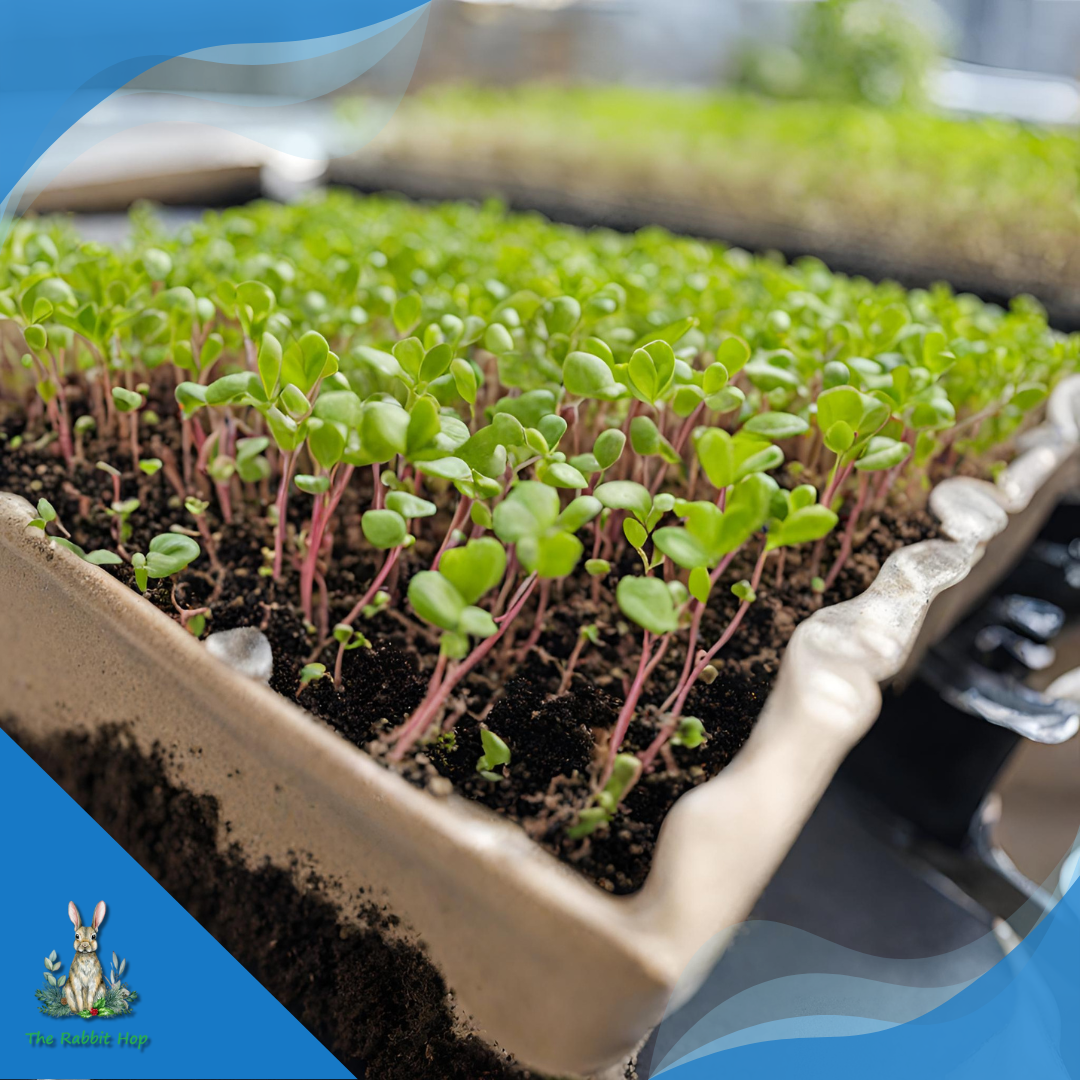
Incredible Benefits
Let’s take a closer look at some of the benefits. First, microgreens are high in fiber, which helps promote healthy digestion in rabbits. They also contain a good amount of water, which can aid in hydration, especially for rabbits that don’t drink much water. Microgreens also provide a source of mental stimulation and enrichment for your rabbit, as they enjoy foraging and nibbling on these fresh greens.
Furthermore, the high levels of antioxidants in microgreens can help support your rabbit’s immune system, reducing the risk of diseases. The vitamins and minerals in microgreens, like vitamin K, vitamin C, and iron, contribute to your rabbit’s overall health, supporting bone health, blood health, and more.
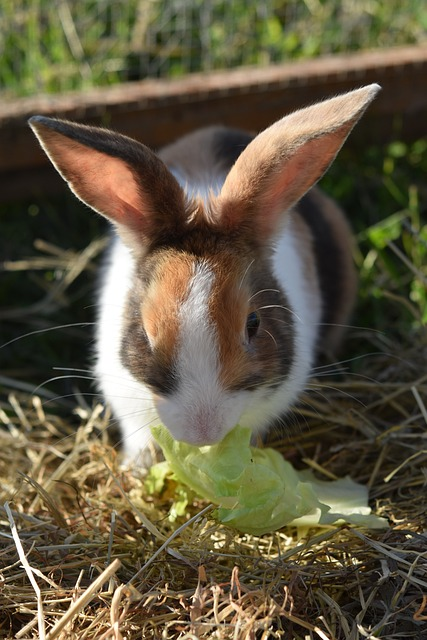
Understanding Rabbit Diet: Can Rabbits Eat Sprouts, Alfalfa, Pea Shoots, Chia Sprouts, and Watercress?
Now, you might be wondering: can rabbits eat microgreens? Can rabbits eat sprouts, alfalfa, pea shoots, chia sprouts, and watercress? The answer is yes; rabbits can eat these microgreens but with some considerations.

Sprouts vs. Microgreens
Sprouts, while nutritious, can present a slight risk of bacterial contamination if not adequately grown and washed. So, if you feed your rabbits sprouts, please ensure they are fresh and thoroughly cleaned. Alfalfa is high in protein and calcium, which can be beneficial in moderation but may lead to health issues like obesity and bladder stones if overfed.
Pea shoots are an excellent option for rabbits, as they are high in fiber and low in calcium. Chia sprouts are also safe for rabbits, but as they can be pretty mucilaginous, they should be fed in moderation to avoid digestive upset. Watercress is packed with nutrients and can be an excellent addition to your rabbit’s diet, but moderation is key.
The takeaway is that while these microgreens can be a part of your rabbit’s diet, they should keep the critical components of their diet: hay, a small number of high-quality pellets, and a variety of other fresh vegetables.
Step-by-Step Guide to Growing Microgreens for Pet Rabbits
Growing microgreens for pet rabbits is a fun and rewarding endeavor. Here’s a step-by-step guide to get you started.

Step 1: Gather Your Supplies
You’ll need a shallow tray, a growing medium like soil or coconut coir, a spray bottle for watering, and, of course, your seeds.
Step 2: Prepare Your Tray
Fill your tray with about an inch of your growing medium, ensuring it’s evenly spread.
Step 3: Sow Your Seeds
Sprinkle your seeds evenly across the surface of the growing medium. You want a dense but not overcrowded layer of seeds.
Step 4: Cover Your Seeds
Lightly cover your seeds with a thin layer of your growing medium.
Step 5: Water and Wait
Mist your seeds with your spray bottle, then place your tray in a location with bright, indirect light. Keep the growing medium moist but not waterlogged.
Step 6: Harvest
Once your microgreens have grown their first set of true leaves, they’re ready to harvest! Snip them off above the soil line with a pair of clean scissors.
Step 7: Repeat
Remember, growing microgreens is a continuous process. As soon as you harvest one batch, you can start another. As you gather, disinfect your growing containers, then create a new bunch. This way, you’ll always have a fresh supply of microgreens for your bunny.
Disinfecting the equipment helps ensure future microgreens don’t harbor harmful bacteria. Please go ahead and rinse well after disinfecting to ensure no toxic chemicals remain. Better yet, disinfect with safe products such as peroxide and allow to dry in full sun for natural disinfecting.

The Best Microgreens for Your Pet Rabbit: Sprouts, Alfalfa, Pea Shoots, Chia Sprouts, and Watercress
When choosing which microgreens to grow for your pet rabbit, it’s essential to consider their nutritional needs and preferences. The five types of young greens we mentioned earlier – sprouts, alfalfa, pea shoots, chia sprouts, and watercress – are all excellent choices. You might grow an entire salad indoors and enjoy some with your rabbit! <source: Grow Salad Indoors: HousePlantJoy.com >
When feeding your pet microgreens, consider these types first. As he continues eating microgreens, you might add more types for variety.

Sprouts:
While you can grow many types of sprouts, try starting with broccoli sprouts or radish sprouts. These are fast-growing and are packed with nutrients.
Alfalfa:
Alfalfa microgreens are a favorite among many rabbits. They’re high in protein and calcium, making them an excellent supplement for growing or nursing rabbits.
Clover:
Roaming around your yard, your pet rabbit might find clover and nibble happily. It turns out that clover microgreens or clover sprouts are a favorite of our pet bunnies.
Broccoli:
Broccoli microgreens or broccoli sprouts provide good nutritious microgreens for rabbits. Most bunnies love these healthy greens.
Dandelion:
Rabbits love dandelion greens. While many people consider these a weed, it turns out that dandelion greens contain many nutritional benefits for your rabbit’s stomach.
Radish:
Radish microgreens are a great addition to add to your bunny’s diet. They help contribute to healthy rabbits. While they are not milder microgreens, they have significant health benefits.
Mustard greens:
Like radish microgreens, mustard greens provide significant health benefits. Like mature vegetables, mustard greens have a bit of tang that rabbits enjoy.
Pea shoots:
Pea shoots are a fantastic choice because they’re high in fiber and low in calcium. Plus, their sweet, pea-like flavor is often a hit with rabbits.
Chia sprouts:
Chia sprouts are nutrient-dense, offering a good omega-3 fatty acids, fiber, and protein source.
Watercress:
Watercress microgreens are packed with vitamins and minerals, and their slightly spicy flavor can be a fun addition to your rabbit’s diet.
Sunflower and Similar Seeds:
Sunflowers, pumpkins, and similar vegetables produce more substantial microgreens for rabbits. We find that our pet rabbits love to eat microgreens containing sunflower sprouts.
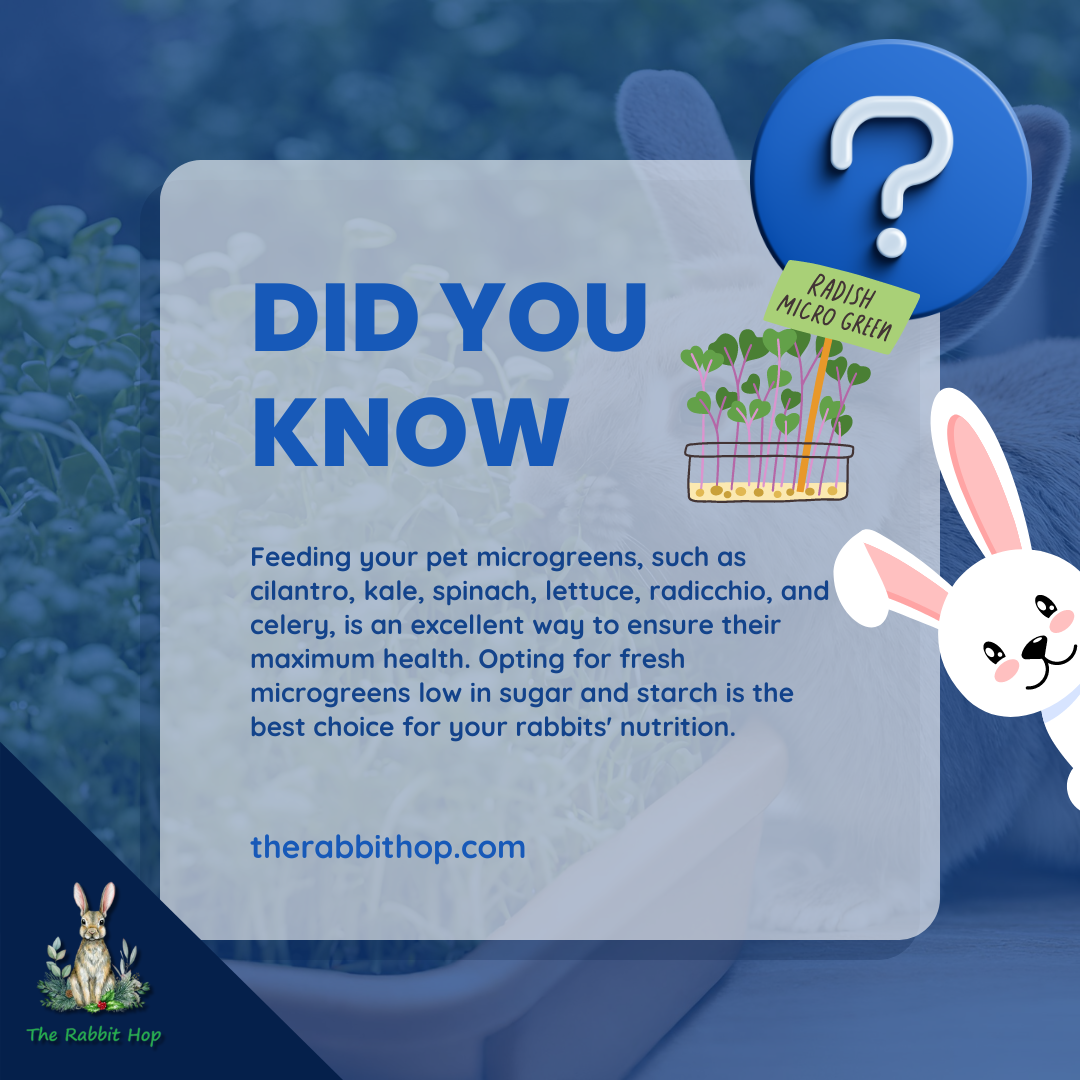
Experiment with different types of microgreens to see what your rabbit prefers. Just introduce any new food slowly to avoid upsetting their delicate digestive system.

Tips for Introducing Microgreens Into Your Rabbit’s Diet
When introducing microgreens into your rabbit’s diet, it’s essential to take it slow. Start by offering a small amount of one type of microgreen. Monitor your rabbit’s behavior and droppings to make sure they’re not experiencing any digestive upset. If all seems well after a few days, you can gradually increase the amount of that microgreen.
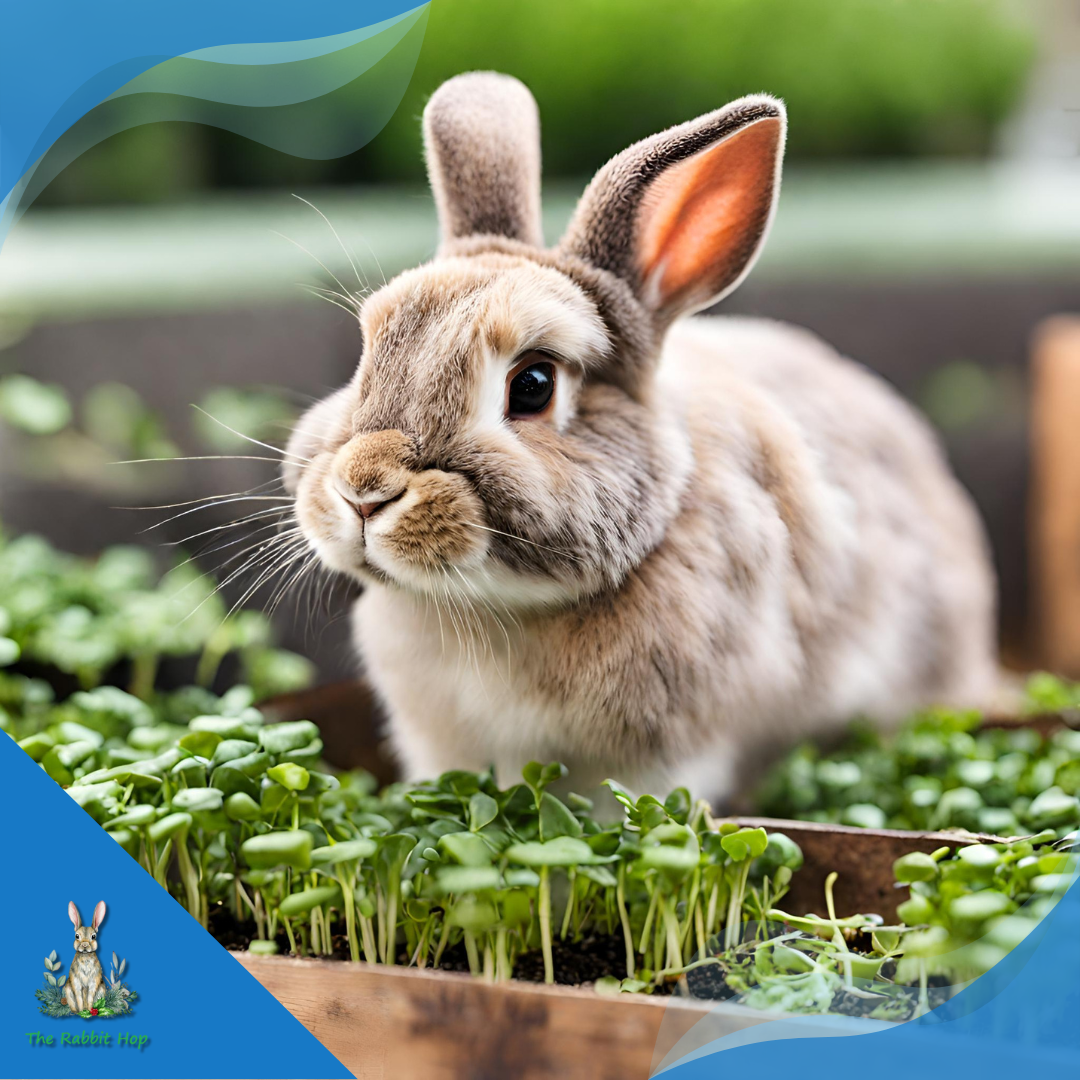
Once your rabbit is used to one type of microgreen, you can start introducing others, one at a time. This slow introduction helps ensure your rabbit’s digestive system can handle the new food and allows you to monitor for adverse reactions.
Remember, while microgreens are healthy and beneficial, they should not make up most of your rabbit’s diet. Hay should still be the primary food, with microgreens, other vegetables, and small pellets as supplements.
Common Mistakes to Avoid When Feeding Microgreens to Rabbits
While microgreens can be a great addition to your rabbit’s diet, there are some common mistakes to avoid.

Overfeeding: Microgreens are nutritious but should not make up most of your rabbit’s diet. Overfeeding microgreens can lead to nutritional imbalances and digestive issues.
Not correctly washing: microgreens can carry bacteria or pesticides like fresh produce. Always wash your microgreens thoroughly before feeding them to your rabbit.
Growing in unsanitary conditions: If you’re growing your microgreens, keeping your growing environment clean to prevent bacterial growth is essential.
Not rotating varieties: Just like humans, rabbits benefit from a varied diet. Try to turn the types of microgreens you feed your rabbit to ensure they’re getting a range of nutrients.
How to Store and Preserve Microgreens for Rabbits
Once you’ve harvested your microgreens, storing them properly is essential to keep them fresh. Here’s how to do it.
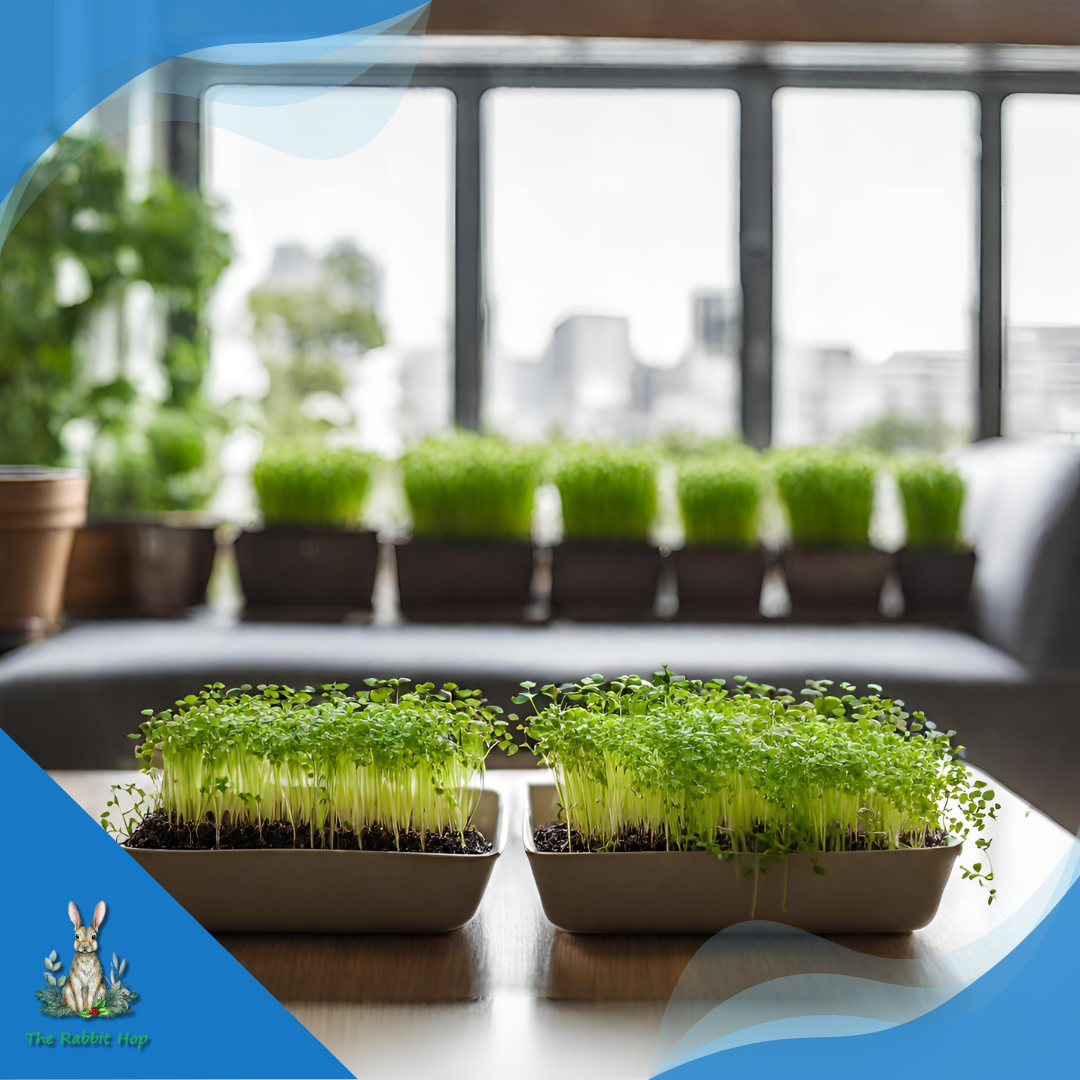
First, gently rinse your microgreens under cool water. Then, pat them dry or use a salad spinner to remove excess moisture. Excess water can cause your microgreens to rot, so getting them as dry as possible is crucial.
Next, place your microgreens in a container lined with paper towels. The paper towels will help absorb any remaining moisture. Store your microgreens in the refrigerator. They should stay fresh for about a week.
Lastly, please don’t cut your microgreens until you are ready to use them. Microgreens will last longer if they’re stored whole.

Other Nutritious Foods to Complement Microgreens for a Balanced Rabbit Diet
While microgreens can be a great addition to your rabbit’s diet, they’re not the only nutritious food you can offer. Other fresh vegetables like bell peppers, carrots, cucumber, and leafy greens like romaine lettuce and kale can also be beneficial.
Fruits can also be offered in moderation due to their high sugar content. Apples, bananas, and berries are all safe for rabbits.
Remember, the foundation of a rabbit’s diet should be high-quality hay supplemented with fresh vegetables, a small amount of pellets, and occasional fruit.
Healthy Rabbits Eat Microgreens!
Microgreens offer a fantastic addition to your pet rabbit’s diet. Our rabbits enjoy them and so do other furry friends of ours worldwide. They might be tasty to our buddies, but they’re packed with nutrients, easy to grow at home. We can even say that most of the rabbits love them! Remember to introduce them gradually, monitor your rabbit for adverse reactions, and balance them with other foods for a well-rounded diet.

Whether you’re a seasoned rabbit owner or just considering bringing one into your home, growing microgreens for your pet rabbit can be rewarding. Give it a try, and enjoy providing fresh, home-grown food for your furry friend. Tell us about your experience in the comments section, too.
FAQs
Can I grow microgreens for my pet rabbits indoors?
Yes, definitely! Microgreens can be easily grown indoors, providing fresh and nutritious greens for your bunnies year-round.
What are the best microgreens to grow for my pet rabbits?
Great choices include wheatgrass, sunflower, and alfalfa microgreens. These varieties are safe and packed with essential nutrients for your furry friends.
How long does it take to grow microgreens for my rabbits to munch on?
Microgreens typically reach a suitable size for rabbit consumption within 7 to 14 days, depending on the type of greens you choose to grow. They’ll be ready for your bunnies to enjoy in no time!
🐰🌟 Discover The Rabbit Hop 🌟🐰
👉 Dive into a world of rabbit care and companionship at The Rabbit Hop! 👈
🥕🏠 Explore our website: https://therabbithop.com/
📚 Engaging Content: Learn valuable tips, tricks, and expert advice on rabbit care, health, and behavior. 📚
🛍️ Product Reviews: Find the best products for your furry friends, from toys to treats and everything in between! 🛍️
💬 Connect with a Passionate Community: Join fellow rabbit lovers, share experiences, and get support from our friendly community. 💬
Hop on over to The Rabbit Hop now! 🐇🌈 Visit us at: https://therabbithop.com/

